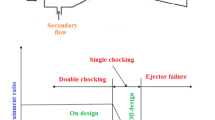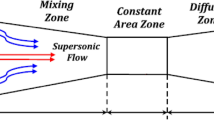Abstract
This paper proposes an integrated numerical–experimental study of a fixed geometry ejector designed for a cooling system activated by waste heat. Ejector operation is analyzed for cases of imposed input and output sets of conditions in terms of pressures and/or temperatures. Experiments with constant primary conditions and secondary temperature were conducted in a range of outlet pressures for model validation purposes. A parametric analysis was then performed for constant pressure and temperature conditions at both inputs (primary and secondary) by varying the outlet pressure. For each test case, performance in terms of entrainment ratio, local parameters distributions (P, M, τ) and the internal flow structure were analyzed in an attempt to establish a link between the external constraints, the flow structure, the operation stability and performance within the range of cooling applications. The ranges of operating conditions investigated were Pp = 4.77 bar, Tp = 83 °C and, respectively, 1.7 ≤ Pc ≤ 2.4 bar, 12.5 °C ≤ Te ≤ 16.5 °C, at saturation. Experimental entrainment ratio, ERexp in the range of 0.12–0.22 was numerically simulated within ± 10%. It was shown that both the ejector operation and the internal flow configurations were sensitive to backpressure. More particularly, an optimal backpressure exists to which corresponds an on-design conditions with maximized entrainment ratio and a shock-wave train located at the end of the mixing chamber. A backpressure increase sets the ejector in off design. This mode of operation is characterized by a shift of the shock train toward the inlets, a disturbance of the flow configuration, a diminution of the entrainment ratio and a deterioration of the operation stability. On the other hand, a backpressure decrease does not affect the ejector stability of operation at its maximum entrainment ratio for the prevailing conditions.


















Similar content being viewed by others
Abbreviations
- \(CFD\) :
-
Computational fluid dynamics
- \(COP\) :
-
Coefficient of performance
- \(ER\) :
-
Entrainment ratio
- \(ERC\) :
-
Ejector refrigeration cycle
- \(ERS\) :
-
Ejector refrigeration system
- \(EXP\) :
-
Experimental
- \(PR\) :
-
Pressure ratio
- \(D\) :
-
Diameter [mm]
- \(L\) :
-
Length [mm]
- \({m}_{1}\) :
-
Generator mass flow rate [kg.s−1]
- \({m}_{2}\) :
-
Evaporator mass flow rate [kg.s−1]
- \(Ma\) :
-
Mach number
- V:
-
Velocity [m.s−1]
- \(NXP\) :
-
Primary nozzle exit position [mm]
- \(\mathrm{P}\) :
-
Pressure [bar]
- \({p}_{C}\) :
-
Condensing pressure [bar]
- \({p}_{\mathrm{E}}\) :
-
Evaporating pressure [bar]
- \({p}_{\mathrm{p}}\) :
-
Primary pressure [bar]
- \(Qe\) :
-
Cooling load [kW]
- \(Qg\) :
-
Generator thermal energy [kW]
- \(s\) :
-
Specific entropy [J.kg−1.K−1)]
- \(\mathrm{T}\) :
-
Static temperature [°C]
- \(Wp\) :
-
Electrical work required for the pump [kW
- \({\Delta T}_{sup}\) :
-
Superheating temperature [°C]
- \(\tau \) :
-
Axial-wall shear stress [Pa]
References
Bartosiewicz, Y.; Aidoun, Z.; Desevaux, P.; Mercadier, Y.: Numerical and experimental investigations on supersonic ejectors. Int. J. Heat Fluid Flow 26(1), 56–70 (2005). https://doi.org/10.1016/j.ijheatfluidflow.2004.07.003
Eames, I.W.; Aphornratana, S.; Sun, D.-W.: The jet-pump cycle—A low cost refrigerator option powered by waste heat. Heat Recovery Syst. CHP 15(8), 711–721 (1995). https://doi.org/10.1016/0890-4332(95)00006-K
Aidoun, Z.; Ouzzane, M.: The effect of operating conditions on the performance of a supersonic ejector for refrigeration. Int. J. Refrig 27(8), 974–984 (2004). https://doi.org/10.1016/j.ijrefrig.2004.05.006
Thongtip, T.; Aphornratana, S.: An alternative analysis applied to investigate the ejector performance used in R141b jet-pump refrigeration system. Int. J. Refrig 53, 20–33 (2015). https://doi.org/10.1016/j.ijrefrig.2015.01.017
Wang, L.; Wang, C.; Hou, W.; Zhao, H.; Zhang, H.: Experimental investigation on ejector performance near critical back pressure. Int. J. Refrig 80, 158–168 (2017). https://doi.org/10.1016/j.ijrefrig.2017.05.010
Eames, I.W.; Ablwaifa, A.E.; Petrenko, V.: Results of an experimental study of an advanced jet-pump refrigerator operating with R245fa. Appl. Therm. Eng. 27(17), 2833–2840 (2007). https://doi.org/10.1016/j.applthermaleng.2006.12.009
Matsuo, K.; Sasaguchi, K.; Kiyotoki, Y.; Mochizuki, H.: Investigation of Supersonic Air Ejectors : Part 2, Effects of Throat-Area-Ratio on Ejector Performance. Bulletin of JSME 25(210), 1898–1905 (1982). https://doi.org/10.1299/jsme1958.25.1898
Bouhanguel, A.; Desevaux, P.; Gavignet, E.: Flow visualization in supersonic ejectors using laser tomography techniques. Int. J. Refrig 34(7), 1633–1640 (2011). https://doi.org/10.1016/j.ijrefrig.2010.08.017
Zhu, Y.; Jiang, P.: Experimental and analytical studies on the shock wave length in convergent and convergent–divergent nozzle ejectors. Energy Convers. Manage. 88, 907–914 (2014). https://doi.org/10.1016/j.enconman.2014.09.023
Chen, Y.-M.; Sun, C.-Y.: Experimental study of the performance characteristics of a steam-ejector refrigeration system. Exp. Thermal Fluid Sci. 15(4), 384–394 (1997). https://doi.org/10.1016/S0894-1777(97)00006-X
Little, A.B.; Garimella, S.: Shadowgraph visualization of condensing R134a flow through ejectors. Int. J. Refrig 68, 118–129 (2016). https://doi.org/10.1016/j.ijrefrig.2016.04.018
Munday, J.T.; Bagster, D.F.: A New Ejector Theory Applied to Steam Jet Refrigeration. Ind. Eng. Chem. Process. Des. Dev. 16(4), 442–449 (1977). https://doi.org/10.1021/i260064a003
Croquer, S.; Poncet, S.; Aidoun, Z.: Turbulence modeling of a single-phase R134a supersonic ejector. Part 2: Local flow structure and exergy analysis. Int. J. Refrig. (2016). https://doi.org/10.1016/j.ijrefrig.2015.07.029
Lamberts, O.; Chatelain, P.; Bartosiewicz, Y.: Numerical and experimental evidence of the Fabri-choking in a supersonic ejector. Int. J. Heat Fluid Flow 69, 194–209 (2018). https://doi.org/10.1016/j.ijheatfluidflow.2018.01.002
Matsuo, K.; Miyazato, Y.; Kim, H.-D.: Shock train and pseudo-shock phenomena in internal gas flows. Prog. Aerosp. Sci. 35(1), 33–100 (1999). https://doi.org/10.1016/S0376-0421(98)00011-6
Sriveerakul, T.; Aphornratana, S.; Chunnanond, K.: Performance prediction of steam ejector using computational fluid dynamics : Part 1. Validation of the CFD results. Int. J. Therm. Sci. (2007). https://doi.org/10.1016/j.ijthermalsci.2006.10.014
Sriveerakul, T.; Aphornratana, S.; Chunnanond, K.: Performance prediction of steam ejector using computational fluid dynamics: Part 2. Flow structure of a steam ejector influenced by operating pressures and geometries. Int. J. Ther. Sci. 46(8), 823–833 (2007). https://doi.org/10.1016/j.ijthermalsci.2006.10.012
Desevaux, P.; Hostache, G.; Jacquet, P.: Static pressure measurement along the centerline of an induced flow ejector. Exp. Fluids 16(3), 289–291 (1994). https://doi.org/10.1007/BF00206550
Zhu, Y.; Cai, W.; Wen, C.; Li, Y.: Numerical investigation of geometry parameters for design of high performance ejectors. Appl. Therm. Eng. 29(5), 898–905 (2009). https://doi.org/10.1016/j.applthermaleng.2008.04.025
Hakkaki-Fard, A.; Aidoun, Z.; Ouzzane, M.: A computational methodology for ejector design and performance maximisation. Energy Convers. Manage. 105, 1291–1302 (2015). https://doi.org/10.1016/j.enconman.2015.08.070
Allouche, Y.; Bouden, C.; Varga, S.: A CFD analysis of the flow structure inside a steam ejector to identify the suitable experimental operating conditions for a solar-driven refrigeration system. Int. J. Refrig 39, 186–195 (2014). https://doi.org/10.1016/j.ijrefrig.2013.07.027
Han, Y.; Wang, X.; Sun, H.; Zhang, G.; Guo, L.; Tu, J.: CFD simulation on the boundary layer separation in the steam ejector and its influence on the pum** performance. Energy 167, 469–483 (2019). https://doi.org/10.1016/j.energy.2018.10.195
A. Bouhanguel, "Numerical and experimental study of the interaction of two compressible flows in supersonic air ejector. Etude numérique et expérimentale de l’interaction entre deux écoulements compressibles dans un éjecteur supersonique," Université de Franche-Comté, (2013)
Mazzelli, F.; Milazzo, A.: Performance analysis of a supersonic ejector cycle working with R245fa. Int. J. Refrig 49, 79–92 (2015). https://doi.org/10.1016/j.ijrefrig.2014.09.020
S. Croquer, "Combined CFD and Thermodynamic Analysis of a Supersonic Ejector with Liquid Droplets," Ph. D. Thesis, Université de Sherbrooke, Sherbrooke, QC, Canada, (2018)
Hemidi, A.; Henry, F.; Leclaire, S.; Seynhaeve, J.-M.; Bartosiewicz, Y.: CFD analysis of a supersonic air ejector. Part I: Experimental validation of single-phase and two-phase operation. Appl. Therm. Eng. (2008). https://doi.org/10.1016/j.applthermaleng.2008.07.003
Fang, Y.; Croquer, S.; Poncet, S.; Aidoun, Z.; Bartosiewicz, Y.: Drop-in replacement in a R134 ejector refrigeration cycle by HFO refrigerants. Int. J. Refrig 77, 87–98 (2017). https://doi.org/10.1016/j.ijrefrig.2017.02.028
Hamzaoui, M.; Nesreddine, H.; Aidoun, Z.; Balistrou, M.: Experimental study of a low grade heat driven ejector cooling system using the working fluid R245fa. Int. J. Refrig 86, 388–400 (2018). https://doi.org/10.1016/j.ijrefrig.2017.11.018
Zegenhagen, M.T.; Ziegler, F.: Experimental investigation of the characteristics of a jet-ejector and a jet-ejector cooling system operating with R134a as a refrigerant. Int. J. Refrig 56, 173–185 (2015). https://doi.org/10.1016/j.ijrefrig.2015.01.001
H. Nesreddine, A. Bendaoud, Z. Aidoun, M. Ouzzane, and B. Le Lostec, "Experimental investigation of an ejector-compression cascade system activated with low-grade waste heat," in Proceedings of the 24th IIR International Congress of Refrigeration, Yokohama, Japan, August, (2015), pp. 16–22.
Zhu, Y.; Jiang, P.: Experimental and numerical investigation of the effect of shock wave characteristics on the ejector performance. Int. J. Refrig 40, 31–42 (2014). https://doi.org/10.1016/j.ijrefrig.2013.11.008
I. Fluent, FLUENT 6.3 user’s guide. Fluent documentation:(2006.) p.
Besagni, G.; Cristiani, N.; Croci, L.; Guédon, G.R.; Inzoli, F.: Computational fluid-dynamics modelling of supersonic ejectors: Screening of modelling approaches comprehensive validation and assessment of ejector component efficiencies. Appl. Therm. Eng. (2021). https://doi.org/10.1016/j.applthermaleng.2020.116431
Besagni, G.; Cristiani, N.; Croci, L.; Guédon, G.R.; Inzoli, F.: Multi-scale evaluation of ejector performances: The influence of refrigerants and ejector design. Appl. Therm. Eng. (2021). https://doi.org/10.1016/j.applthermaleng.2020.116502
Little, A.B.; Bartosiewicz, Y.; Garimella, S.: Visualization and validation of ejector flow field with computational and first-principles analysis. J. Fluids Eng (2015). https://doi.org/10.1016/j.applthermaleng.2020.116502
Pianthong, K.; Seehanam, W.; Behnia, M.; Sriveerakul, T.; Aphornratana, S.: Investigation and improvement of ejector refrigeration system using computational fluid dynamics technique. Energy Convers. Manage. 48(9), 2556–2564 (2007). https://doi.org/10.1016/j.enconman.2007.03.021
Besagni, G.; Mereu, R.; Inzoli, F.: Ejector refrigeration: A comprehensive review. Renew. Sustain. Energy Rev. 53, 373–407 (2016). https://doi.org/10.1016/j.rser.2015.08.059
Ouzzane, M.; Aidoun, Z.: Model development and numerical procedure for detailed ejector analysis and design. Appl. Therm. Eng. 23(18), 2337–2351 (2003). https://doi.org/10.1016/S1359-4311(03)00208-4
Chunnanond, K.; Aphornratana, S.: An experimental investigation of a steam ejector refrigerator: the analysis of the pressure profile along the ejector. Appl. Therm. Eng. 24(2), 311–322 (2004). https://doi.org/10.1016/j.applthermaleng.2003.07.003
Bartosiewicz, Y.; Aidoun, Z.; Mercadier, Y.: Numerical assessment of ejector operation for refrigeration applications based on CFD. Appl. Therm. Eng. 26(5), 604–612 (2006). https://doi.org/10.1016/j.applthermaleng.2005.07.003
Author information
Authors and Affiliations
Corresponding author
Ethics declarations
Conflict of interest
The authors declared that there is no conflict of interest.
Rights and permissions
About this article
Cite this article
Hamzaoui, M., Nesreddine, H. & Aidoun, Z. A Numerical and Experimental Performance Assessment of a Single-Phase Supersonic Ejector. Arab J Sci Eng 47, 8899–8913 (2022). https://doi.org/10.1007/s13369-021-06437-2
Received:
Accepted:
Published:
Issue Date:
DOI: https://doi.org/10.1007/s13369-021-06437-2




